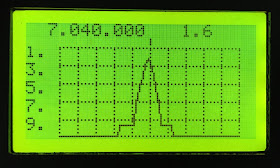It arrived well packed. A solid metal case, fully constructed (for some reason I thought there might be some work to do by me but that was just installing the big knob).
It can be powered either via a DC jack or it has long life running on 6 AA cells. I found that the cells were rather tight and power didn't come on due to some of the cells not being pushed by the springs to the positive contact.
The display is large and clear. One moves around the on-screen items by turning and pushing the knob.
Here's a plot of my 40m dipole. I found the low SWR being at the top a little unfamiliar but it makes sense.
Here's Stephen, VK2BLQ's excellent 40m loop plotted:
- Frequency signal source from 10Khz to 150MHz (and harmonics can be used beyond that).
- SWR meter with plot
- Field strength meter with logarithmic response
- Cable loss measurement
- RF Cable velocity factor
- Modulation meter
- Frequency response - able to plot filters
Best of all the software is open source and, as you can see in the photo above, it's powered by a standard Arduino Nano board. The schematic here. The circuit has:
The main modes are:
- SWR - antenna analyser (use the RF In port)
- PWR - power measurement (Use the RF in port)
- SNA - network analyser (device between RF out and RF in ports)
The RF out is straight from an Si5351 clock generator and looks like this:
Playing around with the user interface, I find it takes more turns that I'd like to move between menu options. There are already a few forks of the software and, like the uBitX, I'm sure we'll see some great improvements built on top of the open software.
This is a great piece of test equipment for a home brewing radio enthusiast.






No comments:
Post a Comment